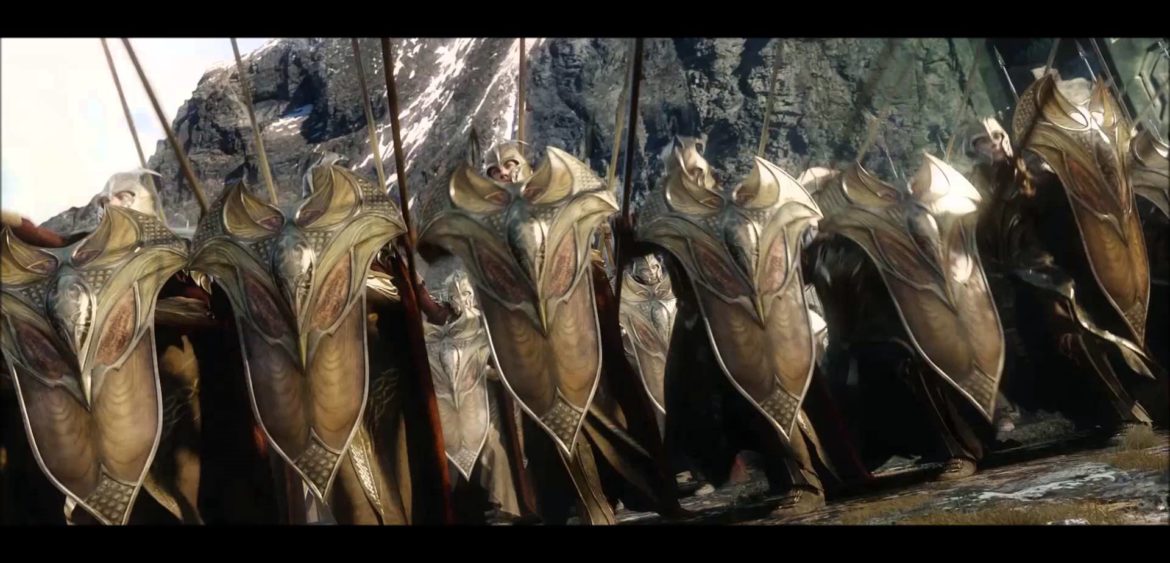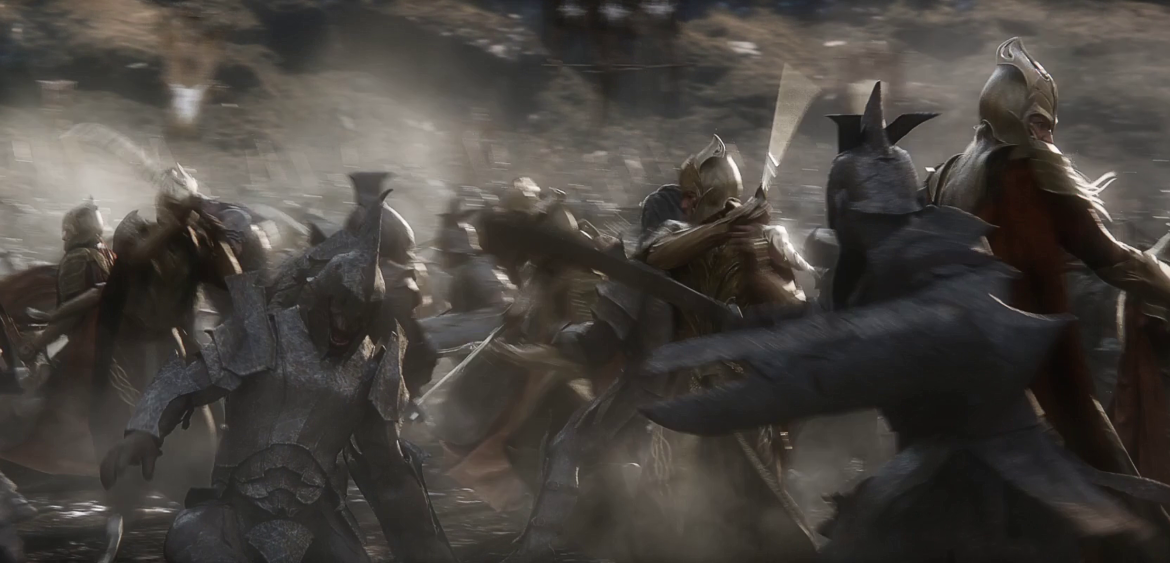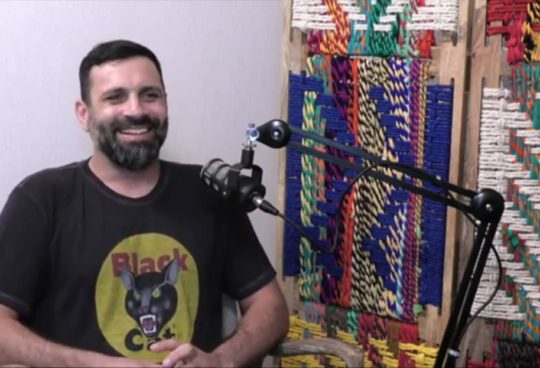Dave Preciado Q&A: “Hobbit” Motion Editor
Filed under: Animation & Effects
December 16, 2014
The Art institutes: What work did you do on The Hobbit Films? What are the steps involved?
Dave: I worked on the last two Hobbit films – “The Hobbit: The Desolation of Smaug” (THB2) and “The Hobbit: The Battle of the Five Armies (THB3). “For THB2, I was on the for the entire post duration of the film, roughly 6 months, and the same on THB3. I’ve worked as a motion editor—basically an animator/technical animator who works with performance capture data, using Giant Studio’s motion editing software called Nuance instead of Maya—on both films. On [THB2] I did get to work on stage with the director, Peter Jackson, during the final month of shooting virtual cameras.
Motion edit and animation are essentially the same thing when it comes to working with mocap (motion capture) data, so we work most closely with the animation department. Both animation and motion edit fall under the “Motion” department at Weta Digital.
As a motion editor, I do a variety of jobs on the film. I clean up motion capture data, solve the performers data onto the CG characters, lay out the scenes with environments, crowds, and camera to send to the director for approval. Then we animate on top of that data to get the desired motion/animation. Once we’re done, we make sure everything in the scene is working in Maya—[this includes] characters, animation/motion, environments and camera—and send it packaged up to the other departments.
Working in camera, we clean up the virtual camera data, make sure time code is correctly matching the directors edit, and prepare the camera to be shipped to the other departments.
The Art Institutes: How do production teams work together and how do they communicate with the director to ensure that the work is meeting his creative vision?
Dave: After the director approves a sequence or shot in its blocking form, every artist is assigned an individual shot and will have a kickoff with the department lead and/or whichever animation supervisor is in charge of overseeing the specific sequence. We are given direction notes on making changes to the shot, such as adding more weight to a prop, adjusting eye lines, smoothing out pops, or fixing footsteps etc. [We do this while] bearing in mind what the other departments may need from us.
Every artist tries to hit those initial notes within a day of the kickoff, but sometimes there are huge scenes with hundreds of characters that we have to work on, or significant performance changes that take a lot more time [to complete]. When we are ready, we submit our shots to dailies and meet with either our department supervisor or the animation supervisor for notes. This process of daily notes and fixes goes on until our shot is approved by the animation supervisor. Then the shot goes in front of the director who would either have additional notes or would give the final approval.
The Art Institutes: Tell us about a major technical or creative challenge that you faced while working on this movie. How did you solve it?
Dave: My job is literally problem solving. Every day I need to figure out how to make the shot work, or a piece of motion work, or why something doesn’t work—and if my solution is viable down the pipe. There are a variety of tools we have at our disposal to attain solutions, but every shot is different and requires a new approach.
Some of the biggest problems we faced in “The Hobbit: The Battle of the Five Armies” were the crowd and battle scenes. Most people would think the crowds on both these films were simulated using the crowd simulator Massive—but they weren’t! All of the battle/crowd scenes were motion edited characters—sometimes up to 700 characters in a single scene! Then Massive would sim (simulate) the far background characters to add even more scale to the scene.
We were given a short amount to time to motion edit these battle scenes, so we had to work efficiently. It takes 45-60 minutes to load/save a scene, so it was quite heavy. We worked with just rigid puppets and motion, so anyone who knows how light a single motion file is, knows that a motion scene taking that long to open is ridiculously huge. These gigantic scenes were broken into groups split between five or six motion editors. We had to work fast, so getting the weapons, shields and character-to-character interaction looking good was an epic undertaking.
The Art Institutes: You worked on this film for half of a year. What was the most surprising thing that you encountered in your work?
Dave: I was surprised most by how big a role the motion edit department has in the pipeline, and the fact that the battles/crowds were Motion edit [software] and not Massive sims [software]. Motion edit can work quickly and efficiently with performance capture data and large crowd data sets.
We make sure all assets are working properly as the director intended—the motion/animation, environments, and camera—before the rest of the company works on the shots. The Animation department does this as well, but since Motion edit tools allow for larger scenes, we can do the bigger crowds more efficiently. Motion edit has a crucial role on these large mocap (motion capture) heavy films.
The Art Institutes: You grew up and worked in Los Angeles before deciding to relocate to New Zealand to work for Weta Digital. How has the transition been, working in a new country?
Dave: I’ve always worked in LA, but when I had the opportunity to work at Weta Digital in New Zealand, I couldn’t pass it up! My dream job in an amazing country? That’s a no brainer. My daughter still lives in Los Angeles, so that’s been the most difficult thing to deal with, but we make the most of it. She comes out to visit once a year and spends her summers with me.
Adjusting to another culture hasn’t been that daunting since Kiwis speak English–although the Kiwi colloquialisms have been the most fun to hear and learn. For example, “chilly bin” is a cooler for drinks. Driving on the other side of the car and road took a while to get used to. I still occasionally open the wrong car door when I drive.
I get to work with the best of the best artists—people from all over the world—here at Weta Digital. That’s been an amazing experience and I’ve made some life long friends that span the globe. That said, I intend to stay and live here in New Zealand—it’s a great country with great people, food, music and culture. I’m incredibly fortunate.
The Art Institutes: How did your education prepare you for your career?
Dave: I gained a great foundation to build on. My education was the best exposure to animation, a VFX/CG (visual effects and computer graphics) pipeline, and to a variety of methods used to problem solve. On top of that, it gave me a network to build on with peers who are out working in the field. I’m still learning, so it never truly ends!
The Art Institutes: What are you working on now? How do you balance life and career?
Dave: In between [the Hobbit movies], I worked on “Dawn of The Planet of The Apes” for 9 months. Next to working on “Avatar” for 2 1/2 years, I was most proud of my work on that film. I got to deliver final animation/motion on many principle character shots with Koba and Caesar—as an artist, that’s incredibly fulfilling and humbling at the same time.
I’d like to tell young people starting off that your time is valuable and your energy and excitement brings a lot to a team. Don’t work (too long) for free! Also, maintain a healthy balance to sustain a long career in VFX. Take care of your bodies, get outside, do other things that aren’t related to the field, so you come back to your workstation in good spirits and with a clear mind. No one wants to sit next to a grump for 15 hours a day!
Tenacity, patience hard work, and perseverance are traits that no institution could teach or provide, but are equal in value to the knowledge gained through education. Believe and know you will succeed if it’s what you love to do.
I’m very thankful to have the privilege of being part of so many amazing projects and to have worked with dozens of talented people. I hope to continue this trend in my future and perhaps tell some of my own stories one day!
Dave Preciado’s Credits:
Film
- “The Hobbit: The Battle of the Five Armies” (2014)
- “Dawn of the Planet of the Apes” (2014)
- “The Hobbit: The Desolation of Smaug” (2013)
- “Jack the Giant Killer” (2012)
- “Sucker Punch” (2011)
- “Battle: Los Angeles (2011)
- “Thor” (2011)
- “Mars Needs Moms” (2011)
- “The Green Lantern” (2011)
- “Hereafter” (2010)
- “Real Steel” (2010)
- “Avatar” (2009)
- “The Mummy: Tomb of the Dragon Emperor” (2008)
- “I am Legend” (2007)
Video games
- “Ride to Hell”
- “Batman: Archam Asylum 2 previz”
- “Tomb Raider 2013”
- “Project Gestault”
- “Saints Row 4”
- “Red Dead Revolver 2”
- “Milo and Kate”
- “UFC 2010”
- “Tomb Raider Turning Point”
- “Nike Exercise”
Cinematics
- “Halo 4”
- “The Cain Chronicles: Cinematic/Pilot”
Commercials
- “Spiderman 4”
- “Red Orchestra 2”
- “Kindgom”
- “Gears of War 3”
- “Bullet Storm”
- “Tron” (CBS)
- “Thor”
Dave Preciado | 2000, Associate of Science, Computer Animation, The Art Institute of California—Los Angeles* | Motion Editor, Weta Digital | * As of 2012, a campus of Argosy University.
Filed under: Animation & Effects
December 16, 2014




Sorry, the comment form is closed at this time.